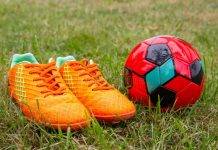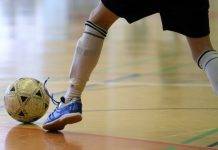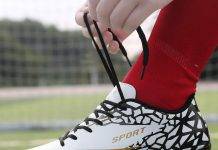So, you’re wondering if there’s a difference between soccer and T-ball cleats? Well, lucky for you, we’ve got all the answers!
While both types of cleats serve a similar purpose in providing traction and stability on the field, some key differences set them apart.
Whether you’re a soccer player or a T-ball enthusiast, understanding these differences can make all the difference in your performance. So, let’s lace up and explore the contrasting features of these specialized footwear options! Yes, there is a difference between soccer cleats and T-ball cleats.
While both are designed to provide traction and support on different playing surfaces, they have distinct features and specifications tailored to the specific needs of each sport.
In this article, we will explore the purpose of cleats, the design features, usage differences, essential factors to consider, a comparison of soccer cleats, a comparison of T Ball cleats, preference and individual needs, safety considerations, and maintenance and longevity.
Purpose of Cleats
Review contents
Traction
One of the primary purposes of both soccer and T-ball cleats is to provide traction on the playing surface. Cleats are designed explicitly with protrusions on the outsole that grip the ground, allowing the player to change direction quickly, accelerate, and decelerate more effectively. Depending on the intended playing surface, these cleat studs or blades can vary in shape, size, and material.
Support and Stability
Another crucial purpose of cleats is to enhance support and stability during gameplay. Both soccer and T-ball involve dynamic movements, such as running, jumping, and pivoting, which require adequate support and stability to prevent injuries. Cleats often feature supportive structures in the upper material, such as overlays and padding, to provide better stability and protect the foot from impact.
Design Features
Outsole
The outsole of the cleats is the portion that comes in direct contact with the playing surface. In soccer cleats, the outsole is typically made of rubber or synthetic materials and features specific stud configurations. These studs can be conical, bladed, or combined to provide optimum traction on differing playing surfaces. In T Ball cleats, the outsole differs depending on the type of cleats chosen, whether rubber, molded, or metal.
Upper Material
The upper material of cleats is responsible for providing support, flexibility, and comfort. In soccer cleats, the upper material is often made of synthetic materials or leather for durability, breathability, and a lightweight feel. T Ball cleats may also use similar materials, but the emphasis might be more on durability and protection due to the nature of the game.
Cleat Configuration
The configuration of the cleats refers to the arrangement and number of the studs on the outsole. In soccer cleats, the configuration can vary depending on the playing surface. For firm ground (FG) cleats the stud pattern is more evenly distributed for balanced traction on dry, natural grass surfaces.
Soft ground (SG) cleats have fewer, longer studs to penetrate wet, muddy fields for better grip. Artificial ground (AG) cleats are designed with shorter, more numerous studs to provide stability on artificial turf. Indoor cleats, conversely, have a rubber or flat outsole for traction on indoor courts.
Usage Differences
Surface Type
The playing surface is a critical factor differentiating soccer cleats from T Ball cleats. Soccer cleats are specifically designed to perform optimally on natural grass or artificial turf surfaces.
The stud configuration and material of soccer cleats are tailored to provide the necessary traction and maneuverability on these surfaces. On the other hand, T Ball cleats can be used on various surfaces, including grass, dirt, or turf, depending on the type of cleats chosen.
Movement Patterns
Another usage difference between soccer and T Ball cleats lies in the movement patterns of the respective sports. Soccer involves constant running, quick changes of direction, and sudden movements, requiring cleats that provide stability during these actions. T Ball, on the other hand, involves more stationary movements with occasional bursts of running, necessitating cleats that offer stability during batting and fielding. Therefore, soccer cleats prioritize agility and multidirectional movements, while T Ball cleats focus more on stability and comfort for intermittent bursts of activity.
Important Factors to Consider
Comfort
Comfort is a crucial factor when choosing soccer or T Ball cleats. Both sports involve extended periods of play, so it is essential to have cleats that you can wear comfortably throughout the game. Look for cleats with cushioning, breathable materials, and a proper fit to minimize discomfort and potential foot issues during long matches or practices.
Fit
A proper fit is vital for optimal performance and to reduce the risk of foot injuries. Cleats that are too tight or too loose can lead to discomfort, blisters, and instability. When selecting cleats, ensure they provide a snug fit without being overly restrictive. Try different sizes and styles to find the right fit for your foot shape.
Durability
The durability of cleats is an essential factor, especially considering the regular wear and tear they experience during gameplay. Look for cleats made from high-quality materials and sturdy construction to withstand the demands of the sport. Reinforced stitching, reliable outsole materials, and protective features in high-wear areas can contribute to the longevity of the cleats.
Price
Price is also a significant consideration when choosing between soccer and T-ball cleats. While you may want the best quality cleats available, it is essential to consider your budget. Cleats can range in price depending on the brand, materials, and additional features. It is always a good idea to balance quality and price to find the best cleats that fit your budget.
Comparison of Soccer Cleats
Firm Ground (FG) Cleats
Firm-ground (FG) cleats are the most common and versatile soccer cleats. They are designed for play on natural grass surfaces and provide excellent traction and stability. The stud configuration of FG cleats typically consists of evenly distributed conical or bladed studs to enable quick changes of direction and sudden stops.
Soft Ground (SG) Cleats
Soft ground (SG) cleats are designed for wet or muddy natural grass surfaces. These cleats feature fewer, longer studs to penetrate the soft ground and provide better grip. The longer studs help prevent players from getting stuck in the mud while allowing for more traction and stability.
Artificial Ground (AG) Cleats
Artificial ground (AG) cleats are designed for synthetic turf or artificial grass surfaces. These cleats usually have shorter studs or a combination of studs and small blades. The shorter studs provide good traction on the artificial surface while reducing the risk of injury or discomfort caused by longer studs.
Indoor Cleats
Indoor cleats, called futsal shoes, are designed for playing on indoor courts or hard surfaces. These cleats have a flat or rubberized outsole, providing excellent grip and traction on smooth indoor surfaces. Indoor cleats are typically more lightweight and flexible than outdoor ones, allowing quick movements and improved ball control.
Comparison of T-Ball Cleats
Rubber Cleats
Rubber cleats are common for T Ball players due to their versatility and durability. These cleats have an outsole made entirely of rubber, which provides good traction on various playing surfaces, including grass and turf. Rubber cleats are often less expensive, making them an accessible choice for young players starting in T Ball.
Molded Cleats
Molded cleats are another popular option for T-ball players. They feature plastic or rubber studs that are permanently attached to the outsole. Molded cleats provide good traction on grass and dirt surfaces and deliver a stable base for running and fielding. These cleats are known for their durability and versatility, making them suitable for players of all ages and levels.
Metal Cleats
Metal cleats are not commonly used in T Ball due to safety reasons. Metal cleats provide excellent traction on grass and dirt surfaces but can be dangerous for young players in terms of injury risk. Most youth leagues and organizations prohibit the use of metal cleats in T Ball to prioritize player safety.
Preference and Individual Needs
Player’s Age and Level
The player’s age and level of play play a significant role in determining the appropriate cleats. Younger players, especially those in T Ball, may benefit from more affordable and versatile options such as rubber or molded cleats. As players progress to higher levels of soccer or T Ball, they may require specialized cleats designed for specific playing surfaces and accommodate the more demanding needs of the sport.
Position
Your soccer or T Ball position can also influence your cleat choice. For example, forwards and attacking players in soccer may prefer cleats that prioritize agility and traction to facilitate quick movements and better ball control. Conversely, defenders may prioritize stability and traction to hold their ground and make tackles. In T Ball, positions like outfielders may require cleats with more traction for better running and catching, while infielders may prioritize stability and protection.
Playing Frequency
The frequency of play is another factor to consider when choosing cleats. Investing in high-quality, durable cleats may be more cost-effective in the long run if you are constantly playing soccer or T Ball. However, if you only play occasionally, opting for more affordable options or cleats that balance price and quality may be more suitable.
Safety Considerations
Injury Risk
Safety is paramount when considering cleats for any sport. Soccer and T-ball cleats should provide adequate support and protection to minimize the risk of foot and ankle injuries. Proper fit and stability are essential in preventing common soccer-related injuries such as sprains and strains. In T Ball, cleats with protective features in the upper material and reinforced construction can reduce the risk of injuries caused by impacts or collisions.
Field Regulations
It is crucial to consider any regulations or rules the sporting organization or league sets regarding cleat use. Some leagues may have specific guidelines on the type of cleats permitted, particularly for T Ball, where metal cleats may be prohibited due to safety concerns. It is always essential to adhere to these regulations to ensure fair play and prevent unnecessary risks.
Maintenance and Longevity
Cleaning
Proper cleaning and maintenance can significantly extend the lifespan of your cleats. After each use, remove any excess dirt or grass from the outsole and upper material. Use a soft brush or cloth to gently clean the cleats, avoiding harsh chemicals that may damage the material. Allow the cleats to air dry in a well-ventilated area before storing them.
Storage
When not in use, it is essential to store cleats properly to maintain their shape and integrity. Avoid leaving them in extreme temperatures or direct sunlight, as this can cause the material to deteriorate. Consider investing in a shoe bag or a dedicated compartment in your sports bag to protect the cleats from damage during transportation or storage.
Replacement Frequency
Cleats will eventually wear out due to regular use and the demands of the sport. It is essential to monitor the condition of your cleats and replace them when necessary. Signs of excessive wear include worn outsole studs, peeling upper material, or loss of support and stability.
While the specific replacement frequency depends on factors such as usage and playing surface, a general guideline is to consider replacing cleats every season or every 6-12 months for regular players.
In conclusion, while soccer and T Ball cleats have similar purposes, they have distinct design features and usage differences to cater to the specific needs of each sport.
Considering essential factors such as comfort, fit, durability, and price can help you decide when selecting cleats. Factors such as the player’s age and level, position, and frequency of play should also be considered.
Safety considerations, such as injury risks and adherence to field regulations, are crucial for player well-being. Proper maintenance and storage can prolong the lifespan of cleats, ensuring they perform optimally and provide the necessary support and traction.
You can choose the right cleats for your soccer or T Ball endeavors by understanding the differences and individual needs.









































